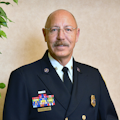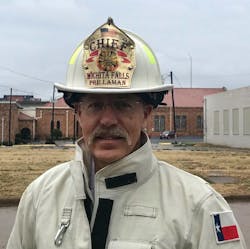Editor's note: Find Firehouse.com's complete coverage of the COVID-19 pandemic here.
Since the beginning of time, we have relied on physicians to decide our fitness for duty following an injury. For significant illnesses (pneumonia, surgeries, cancers), we have done the same. When personnel began testing positive for COVID-19, we accepted Centers for Disease Control (CDC) and local health department guidelines that a 14-day quarantine was sufficient so long as the firefighter was also symptom-free for three of those days. Based upon my experience having contracted the virus, I believe this could be a dangerous practice, and in Wichita Falls, TX, we have changed our policy because of it.
Wichita Falls is a community of 110,000 located in North Texas about halfway between Dallas and Oklahoma City. We are the only all-career Texas fire department within 100 miles, except for the Sheppard Air Force Base Fire Department also located in Wichita Falls. We respond from eight stations to more than 13,000 calls for service annually with a sworn staff of 160. Our minimum daily staffing is 41.
Like most jurisdictions, we responded early in the pandemic by creating policies to keep our members safe, on the job, and virus-free. We made investments in personal protective equipment (PPE) and disinfectants, and for weeks, it felt like our daily mission focused on two things: emergency response and cleaning stuff!
For the first five months of the pandemic, our efforts seemed to be working with only a couple of positive tests among the firefighters and just a few close contacts with family members. As of Dec. 1, we have had a total of 62 members affected by the virus. Thankfully, this only includes 16 of us who tested positive.
I knew I was not well on Saturday, Oct. 24, and stayed down throughout the weekend. With no improvement Monday morning, I arranged for a test and confirmed my suspicions that I was positive for COVID-19. What followed were two of the most challenging weeks I can recall related to sickness. My symptoms included severe fatigue, coughing, no appetite, fever for a couple of days, and challenges with regulating my body temperature. During those two weeks, I lost almost 10 percent of my body weight!
But the portion of my journey that I want to focus on is the five days after getting cleared to return to work, and it’s this segment of time that I believe we as chief officers need to be looking at more closely.
The end of my 14-day quarantine was Sunday, Nov. 8. I wanted to go to church that morning. This would be the first time in more than two weeks that I attempted my usual morning routine: getting up, shaving, showering, getting dressed, and out the door before 8:00 a.m. I noticed when I arrived at church, I was exhausted. What energy I had when I awoke was all used up just getting ready for church. I spent most of the afternoon in a recliner and, throughout the afternoon, dozing.
On Monday, I was excited to get to the station and re-engage with my staff and get back to my regular morning routine. As was the case on Sunday, upon arriving at work, I was already pretty worn out. Knowing what I experienced on Sunday and desiring to make it through the day, I managed my activity and energy throughout those hours to ensure that I made it through to the end.
This continued Tuesday and Wednesday in a similar fashion. Thursday was a noticeable improvement, but it took until Friday (14-day quarantine plus 5) before I truly felt like I was back to 100%. I have heard others refer to this post-quarantine lag as “COVID hangover.” I think it’s a pretty descriptive term and can testify that, at least in my case, it’s a real phenomenon.
Now, let me disclose here that I am 60 years young! I accept the fact that most of my staff have energy stores that I do not have. However, I am a very healthy 60, and my case of COVID certainly wasn’t among the worst we’ve heard about in our community. I also have younger firefighters who had rougher experiences with the virus.
One of the mistakes I had made up to this point with those who had gotten sick was to focus on supporting them while they were out and then getting them back to work. Having never been exposed to this “COVID hangover” phenomenon, I accepted a 14-day quarantine, including three days without symptoms, as evidence that a firefighter was ready to return to work.
If I was still riding on a truck, a single event of pulling a line, forcing a door, or working on air could have wiped me out for the day. And something I know about firefighters is this: few (if any) of my personnel would go to their officer and tell them they were wiped out, and most of you know what I’m talking about. It’s that hard exterior, self-protecting bravado that rears its head in a variety of settings.
The truth is that this “COVID hangover" is real, and it could be impacting our firefighters’ ability to do their job safely, which under the wrong circumstances could have some terrible outcomes. We could have firefighters that need a shift or two before they are 100%.
As a fire chief, I hate that I have put members back on trucks when they may not have been ready, just because federal or local health guidelines say that 14 days (now 10 in many jurisdictions) including three without symptoms makes them “good to go.” As chief, however, I have the authority to do something about it.
Because of this, we have changed our internal hire-back policy to allow a member coming off a COVID sickness (where symptoms were more severe) to return based upon guidance from the health department, but to allow the Battalion Chief to hire back an additional firefighter for that station and rig.
The company officers are being instructed to evaluate each returning member during their first shift back, specifically assessing the impact of a “COVID hangover” and, if necessary, allowing the returning member a light-duty shift. The company officer has the authority to request that the Battalion Chief authorize one additional shift when needed. This change gives us four to six days to ensure that our firefighters are 100% capable of protecting themselves and their partners.
From a fiscal perspective, this change does have a financial impact, but it's a drop in the bucket compared to the cost of an injury or worse. We believe this is a small price for peace of mind, and it accounts for what we know about firefighters and the likelihood they may not always tell you when their ability to do the job is impacted or when doing so makes them look weak before their peers.
As chief officers, we have a responsibility and a moral obligation to protect them from all of that. In Wichita Falls, our experience has changed our view on firefighters being fit for duty under the cloud of COVID-19. If you aren’t doing so already, I encourage you to consider how to support your firefighters after they return so they can re-engage as safely as possible.
About the Author

Kenneth T. Prillaman
Ken Prillaman was appointed fire chief for the City of Wichita Falls, TX, on July 15, 2019. He previously served as fire chief, fire marshal and emergency management director for the City of Brooklyn Park, MN.
He has two associate degrees in fire science and graduated Magna Cum Laude from Columbia Southern University, with a bachelor’s degree in fire administration with a fire investigation major. He is a nationally certified Fire Officer III, Fire Investigator, Fire Instructor II as well as an IAAI-Fire Investigation Technician and Evidence Collection Technician. He is a Minnesota Certified Emergency Management Director and a National Registry EMT. Prillaman has an excellent reputation as a command officer and teaches incident command in high-rise operations for the National Fire Academy. In 2019, he earned his credential as a Chief Fire Officer from the Center for Public Safety Excellence.
Prillaman has served in a variety of regional and state leadership including service as the deputy director in the Minneapolis MACS Emergency Operations Center for Super Bowl 52. He is a member of the North Texas All Hazard Incident Management Team and he serves on the weekend staff of the National Fallen Firefighter Memorial in Emmitsburg, MD. He wrote and published the Minnesota Ceremonies & Protocol Guidebook, heralded as the most comprehensive guide of its type in the fire service.
Ken is an accomplished public speaker and has presented at a variety of local, state and national meetings. He and his family have devoted free time to helping parents keep their kids safe on the internet. His presentation “Parents vs. Predators” has received national acclaim and has been developed into a made-for-television documentary that won a 2012 Telly Award.
He has recently written and published his first book, Leadership Lessons from the Fireground.
Ken and his wife, Debbie, reside in Wichita Falls.
